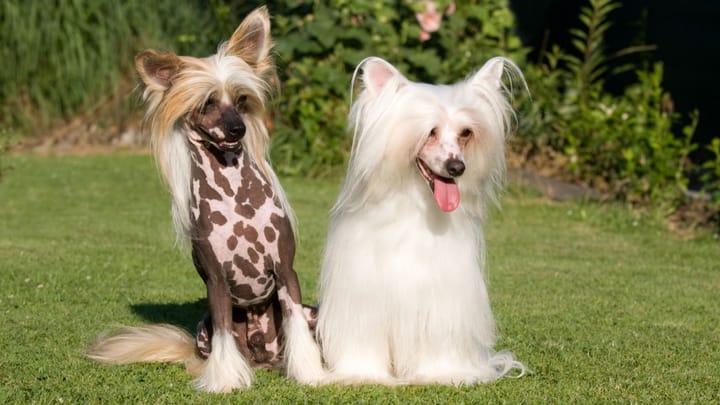Chinese Crested Dog
Other names : Crested, Puff


There are two varieties of Chinese Crested dog: the Hairless and the Powderpuff. Although both types of dog look very different they are in many ways the same (only a genetic mutation separates one from the other). The Hairless type is usually completely hairless with the exception of fine wispy hair on the paws, tail and head. However, the fur of some hairless breeds may grow as long as that seen on the Powderpuff. The characteristics and trainability of each type are the same.
|
Life expectancy |
The Chinese Crested Dog has a life expectancy of between 13 and 15 years |
|
Temperament |
|
|
Size |
Small
|
|
Adult size |
Female
Between 9 and 12 in
Male
Between 11 and 13 in
|
|
Adult weight |
Female
Between 7 and 11 lb
Male
Between 7 and 11 lb
|
| Black White Brown Blue Red Sand | |
|
Type of coat
Hairless: Some hairless breeds have a thin layer of fur that can grow enough to be groomed Hairless: Smooth, soft skin; small single coats of hair on the head, tail and paws. |
Naked |
|
Eye colour
Very dark brown eyes which appear almost black. |
Brown
|
House training a Crested is notoriously difficult to accomplish. Training should be consistent, confident and forthright but on no account should it also be harsh. An adult male Crested that is not castrated will often mark his territory indoors.
More details about the Chinese Crested Dog
Chinese Crested Dog: Origins and history
Supposedly the Crested originated in ancient China and was a dog favoured by some of the ruling families to protect their homes and valuables. The Crested also has a long history of use as a ratter on Chinese trading ships. The first Crested arrived in the United States in 1885 and enjoyed some degree of popularity but from the 1930s onwards until more recently it was not a breed of choice.
Physical characteristics of the Chinese Crested Dog
Hairless: Graceful and fine-boned. Some types of this breed may be bulkier than others. The skin of the hairless is smooth and not too wrinkly, warm to touch and feels like human skin. Graceful, well proportioned head. Tail straight and high is carried upwards when the dog walks but hangs when the dog is still.
Powderpuff: As above but with a generous double coat of fur.
FCI classification of the Chinese Crested Dog
-
Group 9 - Companion and Toy Dogs
-
Section 4 : Hairless Dogs
Chinese Crested Dog: Characteristics
Chinese Crested Dog: Behaviour
Training a Chinese Crested Dog
The Crested is not easy to train and training requires great patience and tolerance. The dog is sensitive and will not respond to anything that resembles harshness or discipline. However, if you succeed in the training of a Chinese Crested you will notice how immensely loyal and obedient the dog becomes.
Chinese Crested Dog: Lifestyle
Breed compatibility Chinese Crested Dog
Chinese Crested Dog: Purchase price
The price for a Chinese Crested can vary according to its origin, gender and age. For a dog registered at the Kennel Club, they will cost on average £615.
Concerning your average monthly budget to satisfy your Chinese Crested’s needs, it will vary between £100 to £140 per month.
Chinese Crested Dog: Shedding
None
The Powderpuff sheds moderately; the hairier types of Hairless will also shed in moderation.
Chinese Crested Dog: Grooming
Hairless: Brush through the areas of fine hair and wash them if necessary but pay more attention to your care of the dog’s skin. Apply oil-based skin creams to the skin of the Hairless; some vets advise the additional use of sun cream during the summer months to protect the dog from sunburn. Be aware: some hairless dogs are allergic to ointments designed for human consumption.
Powderpuff: Bath weekly or when needed and brush frequently to avoid the coat becoming matted and tangled. Do not brush the coat when it is dry; spray a mist of water against the coat before brushing otherwise you will damage the hairs.
Chinese Crested Dog: Health
13 to 18 years.
The Chinese Crested is not a hardy and resilient dog. It has small, fine bones and is easily hurt.
Understandably, the Hairless variety of the Chinese Crested tolerates heat very well. However, even in the summer the Crested needs access to fresh water. Due to its double coat the Powderpuff does not do as well in the heat.
The Hairless Crested does not tolerate the cold; the Powderpuff is marginally more tolerant.
These dogs will eat to obesity, especially if fed human food and exercised less than they should.
- Allergies
- Dental problems
- Legg-Calve disease
- Obesity
- Patellar luxation
- Skin problems








